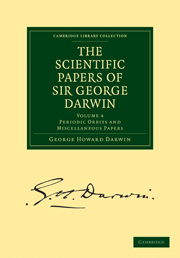Book contents
- Frontmatter
- PREFACE
- Contents
- Chronological List of Papers with References to the Volumes in which they are contained
- Errata
- PART I PERIODIC ORBITS
- PART II THE TIDES
- PART III MISCELLANEOUS PAPERS IN CHRONOLOGICAL ORDER
- PART IV PAPERS ON TIDES (Supplementary to Volume I)
- 22 The Tidal Observations of the British Antarctic Expedition, 1907
- 23 On a Mistake in the Instructions for the use of a certain Apparatus in Tidal Reductions
- PART V ADDRESSES TO SOCIETIES
- APPENDIX
- INDEX
- Plate section
22 - The Tidal Observations of the British Antarctic Expedition, 1907
Published online by Cambridge University Press: 07 September 2010
- Frontmatter
- PREFACE
- Contents
- Chronological List of Papers with References to the Volumes in which they are contained
- Errata
- PART I PERIODIC ORBITS
- PART II THE TIDES
- PART III MISCELLANEOUS PAPERS IN CHRONOLOGICAL ORDER
- PART IV PAPERS ON TIDES (Supplementary to Volume I)
- 22 The Tidal Observations of the British Antarctic Expedition, 1907
- 23 On a Mistake in the Instructions for the use of a certain Apparatus in Tidal Reductions
- PART V ADDRESSES TO SOCIETIES
- APPENDIX
- INDEX
- Plate section
Summary
The present investigation was undertaken at the request of Sir Ernest Shackleton; the expense of the reduction was defrayed by him, and this paper was communicated to the Royal Society by his permission. It will ultimately be republished as a contribution to the volume of the physical results of the expedition.
The first section, describing the method of observing, is by Mr James Murray. The second section explains the reduction of the observations and gives a comparison between the new results and those obtained by the Discovery in 1902–3. The third section is devoted to the discussion of certain remarkable oscillations of mean sea-level and to speculations as to their cause and meaning.
On the Method of Observing the Tides
Early in June, 1908, preparations were begun for the erection of a tidegauge, the most important feature of which was to be a recording apparatus made from a modified barograph. Owing to various delays and mishaps it was not before the middle of July that the gauge was completed in its final form, and the continuous record begun, which was carried on for more than three months, subject only to the loss of half an hour weekly, while the paper was being changed.
Dr Mackay undertook the erection of the instrument, the apparatus was devised by the joint suggestions of Messrs David, Mackay, Mawson, and Murray, while Mr Day did the more delicate part of the work, namely, the alteration of the barograph.
- Type
- Chapter
- Information
- The Scientific Papers of Sir George DarwinPeriodic Orbits and Miscellaneous Papers, pp. 473 - 492Publisher: Cambridge University PressPrint publication year: 2009First published in: 1911



